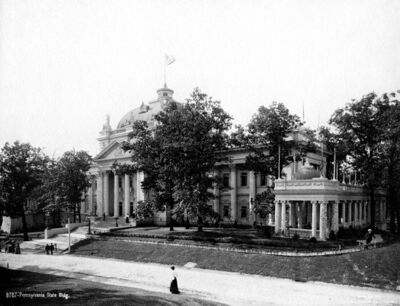Pennsylvania
 | |
| Location | Plateau of States |
|---|---|
| Construction | |
| Construction Cost | $75,000 ($2.26 million in 2021) |
| Architecture | |
| Architect | Philip H. Johnson, of Philadelphia |
| Dimensions | 226' x 105' |
Pennsylvania's entry occupied a conspicuous position on elevated ground within the Plateau of States, and was a two-storied structure, somewhat suggesting the State Capitol.
Description[edit | edit source]
Statues of William Penn stand at the front and rear entrances, and occupying a place of honor in the large rotunda is the famous Liberty Bell.
The most imposing feature was the magnificently proportioned rotunda, with a colonnade of Ionic columns. Twelve semi-circular arches, each containing an allegorical painting, surmount an entablature of great dignity. The color scheme is ivory white and gold. The walls of the rotunda, above the low wainscoting were painted in a rich shade of turquoise blue, with paneled ornamental stenciled work of a very rich ecru tone.
Stationed in the center of the rotunda and protected by a honor guards was the famous Liberty Bell.
On the first floor were rooms for ladies and one for gentlemen, a rotunda, a reception room, smoking room and package room. Native woods and marbles were effectively used in the interior decorations and furnishings.
The second floor had three large "art rooms" and a retiring room, with an attendant, for the convenience of mothers and infants. Also, reading rooms and office apartments completed the rest of the top story.
There was a great collection of founding fathers oil paintings displayed including William Penn.
The ladies' room contained some beautiful furniture, consisting of some large settees, tables, writing desks, and comfortably upholstered easy chairs. The windows were draped with red silk curtains on which were embroidered the coat of arms and other state emblems.
There were no exhibits in the Pennsylvania State Building outside of the portraits of distinguished Pennsylvanians, past and present; 42 of which were displayed, and a collection of pictures loaned by the American Art Society.
Several mural paintings from the Women's School of Design, in Philadelphia, and a series of nearly 100 photographs of the monuments erected to Pennsylvania regiments on the field of Gettysburg.
In one room was an urn covered in 4,000 coins including some from 3,000 BC.
